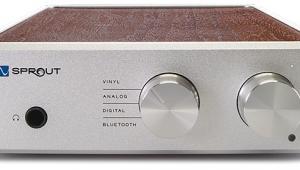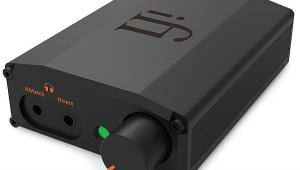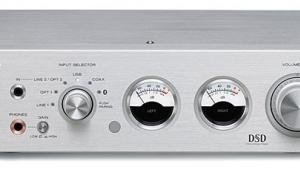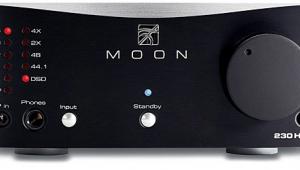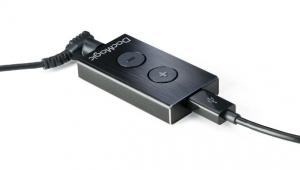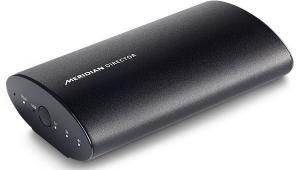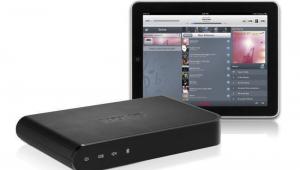PS Audio Sprout and Teac AI-301DA Integrated AmpDACs Review Page 2
I wouldn’t say I heard either the former or latter through my Energy monitors, though this may help to explain that subtle warmth I did hear with some tracks and report on below. Nonetheless, upon seeing the Sprout’s test bench results, I was a bit surprised, but reminded (again) of the truism that tonal balance (frequency response) is indeed a balance, such that, depending on its magnitude, frequency, and “Q,” a change in measured response in the bass may be perceived as “smoother” or “warmer” treble, or vice versa. Speaker designers exploit this understanding knowingly; most electronics designers do not, as our expectations of ruler-flat response and parts-per-million distortion are all but institutionalized.

I began my listening with a movement of Bartók’s Divertimento for strings from a Channel Classics DSD download—a fairly bright, almost edgy recording to begin with—that sounded, at moderate listening levels, more inviting via the Sprout than the AI-301DA. Another Channel Classics download, of a transient-rich guitar-and-percussion arrangement of Falla’s El Amor Brujo, showed both components in a very favorable light. In both cases, the spacious, resonantly three- dimensional sonic image spread well beyond, behind, and even around the two speakers, as graphic a demonstration of high-end soundstaging as one could want. But I noted that the Teac maintained convincing transient snap even at front-row-center levels, while the PS Audio had to be content with a few rows less to avoid edging into incipient hardness.
Or so I felt, at least. To be fair, the necessary interval of several minutes to switch cables and software playback-device settings between each component swap, not to mention the notoriety of auditory memory, made comparison if not actually odorous (as Shakespeare’s Dogberry tells us), then dubious at best.
My preference for DSD source files, though slight, is pretty well established. I find that, on the whole, they sound subjectively better than the mass of high-resolution PCM music—though whether this is real or mere confirmation bias, I cannot say, nor can I easily point to the format or simply the care taken in the process by the mostly smaller audiophile labels that make DSD recordings. The dearth of non-classical/jazz/audio-phokie hi-res audio program material doesn’t trouble me too much, since my serious listening is overwhelmingly classical—though this might change if there were alternatives. Even where an option exists, like Stevie Ray Vaughan and Double Trouble’s classic Couldn’t Stand the Weather in a 176/24 upconversion from HDtracks, the quality rarely challenges even a pedestrian HRA classical (or jazz) offering. Still, some improvements sound convincingly real: There was enough newly uncovered dynamic detail and high-frequency sweetness on the still-amazing “Scuttle Buttin’” to make the journey worth the fare. I heard pick-attack definition and cymbal air that were altogether new—and I heard them just about equally on both the Sprout and the AI-301DA.
Other than the Teac’s already mentioned ultimate-volume advantage—probably not more than a decibel or two with my speakers, if real at all—I heard little else to choose between ’em. On another DSD download, this time a folkie/world track, “Silver Pen,” from one David Elias (via Linn Records), there’s an opening of low notes from a harp (or possibly bajo sexto); these impressed me as marginally richer, or perhaps “weightier,” on the PS Audio. Then again, a denser track like the New Orleans–feel “Jolie Jolie” by Rickie Lee Jones (an HDtracks 192/24 FLAC) tilted me back toward the Teac, for easy transparency and perhaps clearer soundstage depth.
Sometimes I was tempted to characterize the PS Audio as marginally “warmer” and the Teac as just as marginally “transparent-er,” but far more often, I was utterly stumped. I could go back and forth like this all day; suffice it to say that both ampDACs have the goods to display higher-resolution recordings, regardless of format, to advantage.
As headphone amps, both units performed similarly on two sets of cans at my disposal: my everyday Sony MDR-V6 and the Sennheiser HD-25II (both are middle-impedance ’phones, around 75 ohms). I went back and forth repeatedly and reached no lasting conclusion. If you put a gun to my head (but please don’t), I think I’d take the PS Audio’s headphone circuit, which seemed to have a few decibels more output, at least into my ’phones. I happened upon a few online mentions of residual buzz on the Sprout’s headphone output, but this afflicted only a handful of units shipped before PS Audio made a fix; I heard no such noise from my sample.
In any event, I would definitely take the PS Audio’s phono preamp, a decided winner over the Teac’s absent one. I spun a few platters and was quite pleased by open, nicely extended playback.
The Bluetooth discovery pages of both my iPhone 5s and my iPad Mini found the Sprout and the AI-301DA almost immediately, and everything worked fine wirelessly, sounding about as good as I expect A2DP Bluetooth to do—which is, um, pretty good. (I do not currently have a source incorporating the better-sounding aptX codec.) Either way, if Bluetooth is all you need, there are far cheaper solutions. But having it here presents a nice option for pushing music from a handheld, yet another decided nod to modern lifestyle.
The Teac’s sub output is simply a summed mono signal, with no filtering. If you use it, you’ll want a suitable low-pass filter active on your sub’s line input. The same caveat applies if you use the stereo line out on the Sprout to connect a subwoofer; use both left and right connections, and let your sub do the summing.
I encountered no operational glitches whatsoever. Both units worked just as expected, with no turn-on/-off pops (other than small ones on the Sprout’s headphone output), hiccups, or rude noises, and both played every file and format I tossed them, which included DSD, FLAC, AIFF/WAV, and MP3. (Note that the PS Audio will not decode 176/24 files from its coax S/PDIF input, a restriction of its chipset.)
The AI-301AD’s half-sized wand remote controller proved generously laid out and perfectly usable, and it includes transport buttons for Teac’s companion streamer/player components. The Sprout’s ergonomics are even more Spartan: two knobs and a back-panel power switch. There’s no power indicator, which I occasionally found unsettling, but in real life, I suppose I would simply leave the unit on, as I suspect most others would.
The Bottom Line
The value equation is no easier between these two. Teac’s AI-301AD provides remote control, more digital inputs, and a lower price, while PS Audio’s Sprout offers more analog I/O, plus a phono input—and quite a nice-sounding one at that. In my view, shoppers could simply choose the one whose features best meet their needs, or whose ethos answers their aspirations, and not put a foot far wrong.
Catch Rob Sabin's video tour of the PS Audio Sprout and Teac AI-301DA here.


